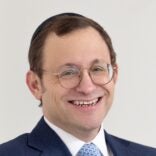Torah connects us to God and to the wisdom of our tradition, gives us direction, makes our life of mitzvot one of depth and meaning. It can, it must, be accessible to all. The Mishna in Avot tells us that the crown of the priesthood is only for Aharon’s descendants, but the crown of the Torah is sitting and waiting for anyone to take.
But is this really true? The menorah, in theory, could be lit by anyone, but in practice, only the kohanim ever did it. The Torah, in theory, can be learned by anyone, but in practice, many have been excluded. Until very recently, women were the most obvious of those excluded from serious Torah study, but today, exclusions persist in more subtle, and sometimes invisible, ways.
Those with learning and developmental disabilities are excluded from the vast majority of Jewish schools and synagogues. Sometimes they are actively rejected, told that they do not “fit in” or will impact the image of the school in a negative way. Other times, the rejection is more by omission than commission. There are not sufficient structures and professionally trained staff to make the school or the shul a feasible option.
Left to their own devices, parents try to homeschool these children in Torah, but what resources are available to them? For many people, the texts of Torah learning are themselves the biggest obstacles. They are dense, difficult, often unpunctuated and written in a foreign language. Where are the Torah graphic novels? Where are the books of halacha, Mishna and Talmud that communicate the depth of our tradition with illustrations and stories, that can be absorbed by those with little or no Hebrew reading skills? Such resources would bring light to all — special education is good education.
For the physically disabled the story is not much better. While we are generally good at building ramps, how often is it that we have the resources available so that the blind or the deaf can learn Torah equally with those blessed with hearing and sight? How many synagogues have braille siddurim? How many lectures make signing or closed captioning available? The Talmud tells us that although a blind person does not directly benefit from light, she still makes the blessing, “Who has created the luminaries,” because she benefits indirectly – a person with sight can see and help guide her. But have we done this? How much do those of us with sight share the benefits of our light? How much do we make sure that the light of the menorah is available to all?
We are doing somewhat better in these issues than we had in the past. Many schools are becoming more invested in ensuring that every child receives a Jewish education, and are working at developing special education programs, although there still is a far way to go. I was pleasantly surprised to discover at a JOFA (Jewish Orthodox Feminist Alliance) conference a few years ago that signing was available, and that during my lecture, multiple signers were signing at breakneck speed. (I tend to talk fast.)
But even the best intentioned among us need to be reminded of this constantly. A few years ago, when Yeshivat Chovevei Torah ran its biannual weeklong program on the rabbi and people with disabilities, we video-recorded the sessions but failed to make closed captioning available, nor did we have any signers present during the week itself. I sometimes feel that I speak a good game, but have not fully internalized the sensitivity and vigilance that is required, that will make providing such access natural and second nature.
In the opening verse of the Torah portion, Tetzaveh, which we recently read in the synagogue, the word tamid, or constantly, stands out. It is a word that occurs twice more in Tetzaveh, by two other Temple services: the offering of the daily communal sacrifices and the burning of the incense. The message is clear: serving God requires daily dedication and consistency. We cannot build a holy community, a place for God to dwell among us, without daily dedication. When we first learn new halachot [Jewish laws], the details and the attention they demand can overwhelm us, but then they become second nature, they become a self-perpetuating tamid. So, too, our daily dedication must include not just the performance of the mitzvot, but also the lighting of the menorah, making the Torah available to all. The details will overwhelm us at first, but if we attend to them tamid, they will become a tamid that becomes natural. And we will have made for ourselves a community wherein God can truly dwell.
Rabbi Dov Linzer is the rabbinic head of Yeshivat Chovevei Torah Rabbinical School in Riverdale.
The New York Jewish Week brings you the stories behind the headlines, keeping you connected to Jewish life in New York. Help sustain the reporting you trust by donating today.





